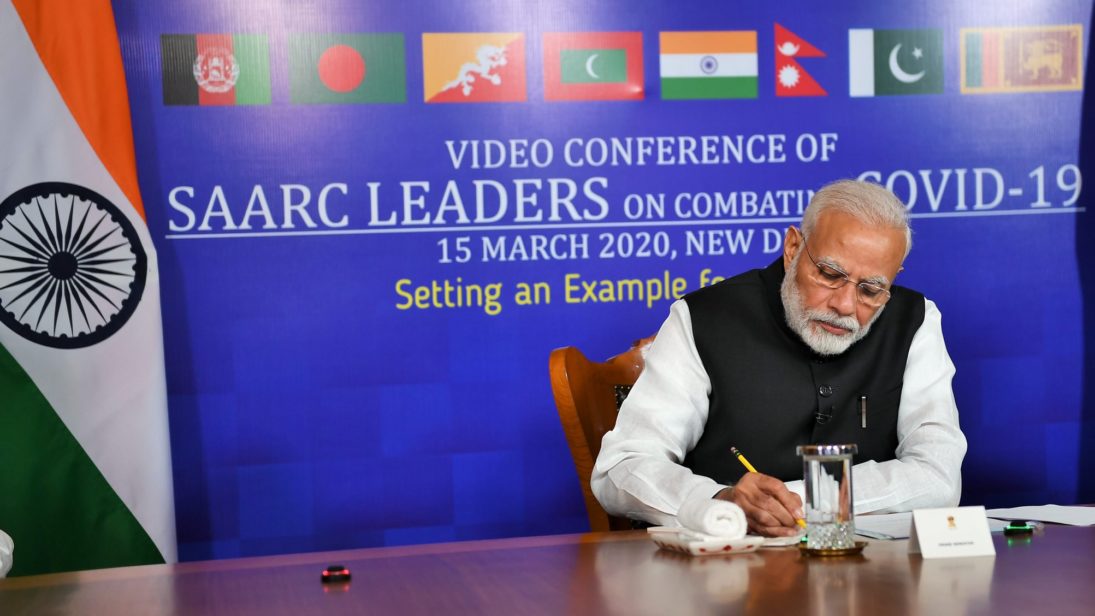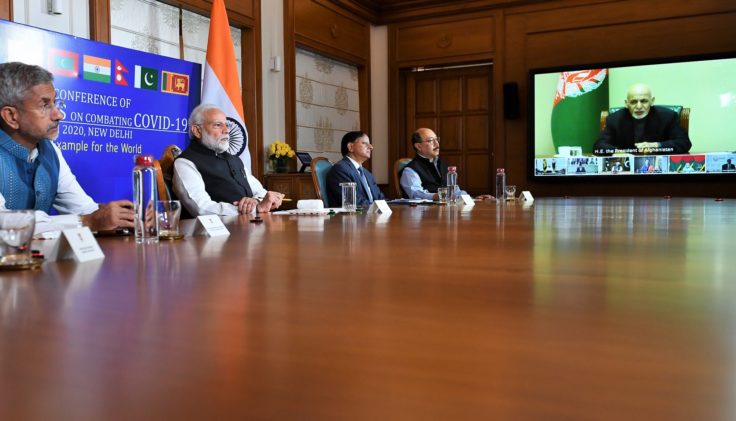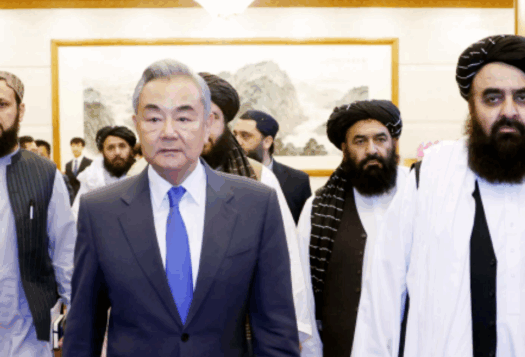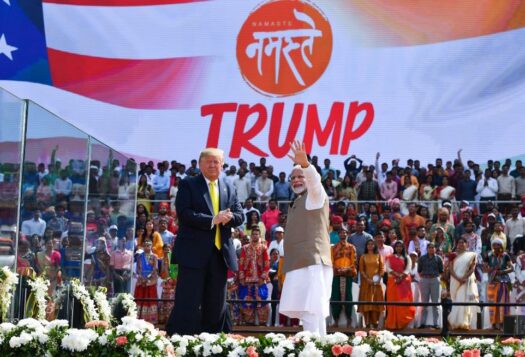
Prime Minister Narendra Modi surprised many when on March 13 he took to Twitter to propose that leaders from the South Asian Association for Regional Cooperation (SAARC) nations meet via video conferencing to “chalk out a strong strategy to fight Coronavirus.” So far, SAARC nations have witnessed over 800 confirmed cases, with India’s confirmed cases reaching 223. Within a couple of hours positive responses started pouring in from the leaders of South Asian nations. The tweet was an important, but rather rare reference to SAARC by Prime Minister Modi on Twitter in the last year.
India has been keeping SAARC at a distance since the 2016 Uri attack, which was conducted by Pakistan-based terrorist organization and led India to subsequently boycott the 19th SAARC summit that was to take place in Islamabad, which was cancelled after multiple countries pulled out following the attacks. Since then, India has shifted its focus towards other sub-regional organizations such as the Bangladesh-Bhutan-India-Nepal (BBIN) initiative and the Bay of Bengal Initiative for Multi-Sectoral Technical and Economic Cooperation (BIMSTEC). Following Modi’s March 13 tweet, many welcomed his video conferencing proposal to strategize how to fight COVID-19 in South Asia and some may have read this as a possible stepping stone towards a return to a normally functioning SAARC. However, there is little in SAARC’s history to suggest it is on its way towards being a viable organization, and the video call held on March 15 further saw resurgence of the same issues—including India-Pakistan bilateral disputes—that have weakened the relevancy of the regional body over the past several decades.
There is little in SAARC’s history to suggest it is on its way towards being a viable organization, and the video call held on March 15 further saw resurgence of the same issues—including India-Pakistan bilateral disputes—that have weakened the relevancy of the regional body over the past several decades.
SAARC’s Structural Weaknesses and Struggle for Relevancy
One must remember that even at its zenith, SAARC grossly fell short of meeting its potential for a host of reasons. Structural problems, the requirement for unanimity in the decision-making processes, and the exclusion of contentious bilateral matters between states from the ambit of SAARC, made the organization politically weak from the start. The primary motivation behind the setting up of the organization in 1985 seemed to be more focused on symbolism, as South Asia was the only key region left without a regional body, and less on a vision for long term socio-economic and security cooperation. Yet, the most significant obstacle facing SAARC is the enduring rivalry between India and Pakistan.
SAARC has not held a summit since 2014, and the only major meeting that has taken place since then has been the traditional foreign minister’s gathering on the side lines of the United Nations General Assembly (UNGA). In fact, last year while addressing the foreign ministers’ informal meeting at the UNGA, India’s Foreign Minister S. Jaishankar said that the survival and relevance of SAARC was contingent on taking actions to eliminate terrorism in the region.
With the stated policy of isolating Pakistan internationally, India for all practical purposes abandoned SAARC after the Uri attacks in 2016. For a few critical reasons, including India’s renewed focus on its “Look East” policy which under the current Indian government transformed into the ‘Act East’ policy as it seeks to counter a China that is increasing its engagement in South and Southeast Asia, India has sought to explore better opportunities offered by other sub-regional groupings like BBIN and BIMSTEC. Even though SAARC failed to achieve significant cooperation among member countries on key issues like connectivity, redirecting focus to BBIN and BIMSTEC has resulted in tangible accomplishments. For instance, BBIN countries signed the Motors Vehicles Act in 2015 to improve regional road connectivity, and the India-Myanmar-Thailand Trilateral Highway that is currently under construction. Further—largely driven by India—BIMSTEC has taken steps towards improving intraregional cooperation on counterterrorism and transnational crime, for instance in 2017 India hosted each member state’s National Security Chief in New Delhi.
This is not to say that these sub-regional organizations do not have problems of their own. BIMSTEC, for instance has held only four summits since it was set up in 1997. However, most of the hurdles faced such as technical, bureaucratic, disagreements over trade or connectivity are faced by most, if not all, nascent regional organizations. The biggest factor is the absence of outright enmity or hostility between two or more states, particularly India, which is a vital catalyst to the process of sub-regional integration and cooperation. Another reason, as mentioned above, is China’s increased presence in South Asia across the spectrum which makes BBIN and BIMSTEC all the more important in India’s outward look in the extended region.

COVID-19 and SAARC
While the deadly virus, which is now a global pandemic, did bring back the term SAARC, this focus is merely issue-based and, in all probability, will not translate into the revival of the organization itself. Pakistan’s cold response to the proposal and its decision to send Dr. Zafar Mirza, the Special Assistant to the Prime Minister on Health, to participate in the conference whereas all other member countries were represented by their heads of state, only proves that the India-Pakistan rivalry will continue to hold SAARC to its current inconsequential levels. During the video conference, despite the conference’s stated focus being battling the coronavirus, Pakistan raised the issue of Kashmir, once again proving that the SAARC process will remain hostage to debates over Kashmir and cross-border terrorism.
While the deadly virus, which is now a global pandemic, did bring back the term SAARC, this focus is merely issue based and, in all probability, will not translate into the revival of the organization itself.
The video conference held on March 15 stuck strictly to the operational measures, suggestions, and details of dealing with the virus, with the impact of COVID-19 already catching up with the region, particularly the smaller states which are more vulnerable to economic shocks, primarily because of tourism dependent economies. During the conference, Prime Minister Modi announced that a COVID-19 emergency fund of $10 million would be set up and that it would be at the disposal of member states for the fight against the outbreak. No substantial suggestions or comments were made about the long-term future of the organization itself.
SAARC’S past record and the current geopolitical dynamics in the region suggest that observers should be careful of reading more into this humanitarian effort than the present reality calls for. India, which shares permeable borders with multiple SAARC member states, may find it in its own national security interests to play a leading role in bringing members to the table to synergize response efforts to COVID-19.
With India’s leadership in SAARC constantly challenged by Pakistan, the lack of significant results due to structural barriers, and India’s increased interest in other sub-regional groupings driven by China’s increasing engagement with South Asian as well as Southeast Asian states, India finds little incentive to spend efforts on reviving SAARC as an organization. While extraordinary situations like the current outbreak can lead to issue-based cooperation, the temporary concurrence is not enough to resolve the long-standing structural and political deficiencies that have kept SAARC from being an effective platform for regional cooperation.
***
Click here to read this article in Urdu.


